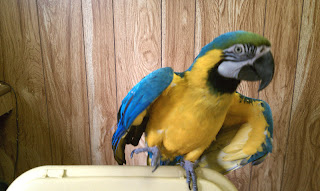When I started my job here
at World Bird Sanctuary, I didn’t know that it would involve some travel… Not
that traveling is a problem, of course.
After all, you pack some
clothes, you grab a road map, and you’re off, right? Well, traveling with WBS is not exactly a vacation. It’s a business trip, and not all of
your co-workers are human. The
prospect was daunting at first.
Traveling to another state with birds? But once you get started, you realize just how much fun
you’ll have.
The first trip I took was
to Keokuk, Iowa, for Eagle Days this January. We took three birds and two snakes on this five-hour,
four-day trek, and Teri (WBS Director of Education), Eleanor (WBS intern), Dave
and Kathy King (WBS volunteers) and I had a good time (except for the fact that Iowa in
January is really cold). Compared to my next trip, however, this
was just a warm-up.
For the past four years,
WBS has made the trek up to Hastings, Minnesota, to present the Masters of
the Sky program at the Carpenter
Nature Center. The first major
difference between Minnesota and Iowa—Minnesota is much further away. The second difference between the
trips—the Iowa trip had five animals who were relatively low-maintenance. The Minnesota trip?...Eight birds of
prey, one of which was a very large eagle… And the third difference—this time, we only had three people
with us: Teri, Daan (WBS intern from the Netherlands) and me. Upon hearing about all of these
differences, I was, I admit, a bit daunted. How were we going to pull off an eight-bird show with only
three people? It turned out to be
a pretty amazing trip.
On March 1st,
we packed up our birds and our supplies and hit the road. It took 9 ½ hours to get from Valley
Park, MO to Hastings, MN. When you
get to where you’re going, you have to set up your bird headquarters, and make
sure that all of your birds are still happy and healthy after the long
trip. When we arrived, we
unloaded, made sure our perches were secure, fed our birds and put them to
bed. Needless to say, Teri, Daan
and I all fell asleep promptly upon arriving at our accommodations.
The next three days were a
flurry of activity. We did 2
school programs for a local elementary school on the morning of the 2nd
(the kids loved seeing Mesquite the Harris’ Hawk flying right over their
heads). That evening, we gave a
show for the Carpenter Nature Center’s annual fundraiser. It was very exciting to use their
facilities—we got some wonderful flights from Goblin the Barn Owl.
On the 3rd and
the 4th, people from all over the area came to watch our shows. They were awed by the flights of Jet
the American Kestrel, laughed at Osiris the Egyptian Vulture’s “feather-do”,
and they loved seeing Mischief the Raven taking donations.
Though the weekend was
action-packed, I was still proud to be there representing World Bird Sanctuary
and St. Louis. I was very pleased
to be part of the team that trucked to Minnesota that weekend.
…As exciting as it was to
present the bird shows, I was equally excited about the northern birds I would
be able to see. On the morning of
the 4th, Teri, Daan and I woke up early. Led by a very generous volunteer at Carpenter Nature Center,
we trekked east of St. Paul and hiked to a small grove of pine trees. Sitting in the branches, clutching a
dead mouse, was a Northern Saw-whet Owl.
This is an owl that is rare to see in
Missouri, and we were all excited to be able to add a bird to our life
lists.
As luck would have it, that
was not the only owl we saw that day.
When we were leaving Carpenter that evening, that same volunteer called
us, and gave us the location of another rare owl…. We drove along Hwy 55, and spotted a Snowy Owl on a
telephone pole searching a nearby field for tasty food.
As tiring as travel
sometimes is, I’m very glad to have had these experiences. It teaches you endurance,
responsibility and patience.
Besides—how often do you go on a business trip and have fun as well?



.jpg)














.jpg)
.jpg)









.jpg)















.jpg)

.jpg)
